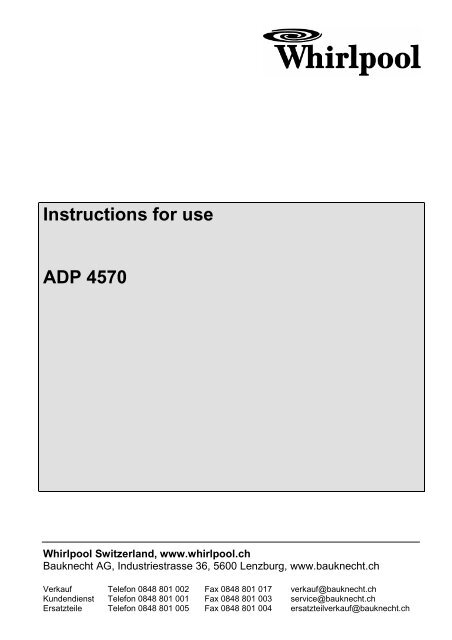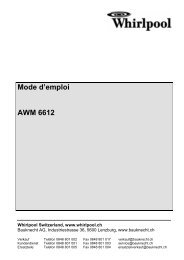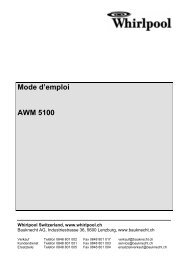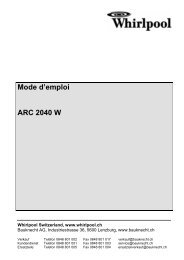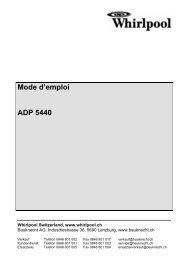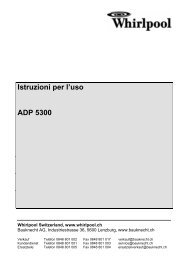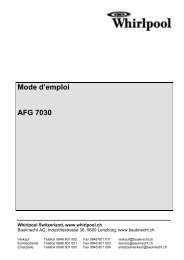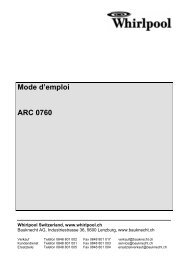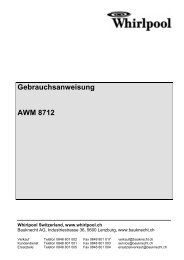Instructions for use ADP 4570 - Whirlpool
Instructions for use ADP 4570 - Whirlpool
Instructions for use ADP 4570 - Whirlpool
Create successful ePaper yourself
Turn your PDF publications into a flip-book with our unique Google optimized e-Paper software.
<strong>Instructions</strong> <strong>for</strong> <strong>use</strong><br />
<strong>ADP</strong> <strong>4570</strong><br />
<strong>Whirlpool</strong> Switzerland, www.whirlpool.ch<br />
Bauknecht AG, Industriestrasse 36, 5600 Lenzburg, www.bauknecht.ch<br />
Verkauf Telefon 0848 801 002 Fax 0848 801 017 verkauf@bauknecht.ch<br />
Kundendienst Telefon 0848 801 001 Fax 0848 801 003 service@bauknecht.ch<br />
Ersatzteile Telefon 0848 801 005 Fax 0848 801 004 ersatzteilverkauf@bauknecht.ch
How to <strong>use</strong> the appliance<br />
Further indications are given in the single chapters and in the <strong>use</strong>r instructions.<br />
Switch on the appliance<br />
Press the ON / OFF button.<br />
Fill the detergent dispenser<br />
Compartment A:<br />
With each wash cycle.<br />
Compartment B:<br />
For programmes with pre-wash only.<br />
If using combined action dishwasher<br />
tabs, follow the <strong>use</strong>r instructions!<br />
A<br />
B C<br />
Check the rinse aid level<br />
Mechanical indicator C.<br />
Electric indicator on control panel (if provided).<br />
Check the<br />
regeneration salt level<br />
On models with water softener<br />
system only.<br />
Mechanical indicator D. Electric<br />
indicator on control panel (if provided).<br />
Load the racks<br />
Refer to the dishwasher loading instructions.<br />
Close the dishwasher door,<br />
turn on the water tap<br />
Select a programme<br />
Select additional options<br />
The last programme selected will light up.<br />
Select the desired programme (using the specific button or knob).<br />
The corresponding indicator lamp lights up.<br />
If necessary (and if provided).<br />
The corresponding indicator lamp lights up.<br />
Wash cycle<br />
Press the Start button<br />
The selected programme is<br />
then memorised (even in the<br />
event of power failure).<br />
“Change programme in progress”<br />
Press the START button <strong>for</strong> 2 sec. until the<br />
Start indicator lamp switches off.<br />
Select another programme and press the<br />
START button again.<br />
- Only open the dishwasher if necessary<br />
(Warning: beware of hot steam).<br />
- If the appliance is switched off during a<br />
wash cycle, when switched on again it<br />
will resume the cycle from where it was<br />
interrupted.<br />
Switch off the appliance<br />
Only after the START button has switched off: Press the ON / OFF button.<br />
All the indicator lamps switch off.<br />
Turn off the water tap,<br />
unload the racks<br />
Warning: When the door is opened steam comes out!<br />
Unload the appliance, starting from the lower rack.
Dishwasher loading instructions and racks provided<br />
Upper rack:<br />
depending on the model<br />
Multi-purpose support (A): 1)<br />
Depending on the position, <strong>for</strong> longhandles<br />
utensils, cups and glasses. May<br />
be <strong>use</strong>d in three different positions.<br />
Crockery holders (B):<br />
Depending on the position, <strong>for</strong> example<br />
plates, cups and long-stemmed glasses.<br />
Revolving glass support (C): 2)<br />
Depending on the position, <strong>for</strong> example<br />
small or long-stemmed glasses.<br />
Long-handled utensils (e.g.<br />
carving <strong>for</strong>ks, knives) must be<br />
arranged with the sharp end<br />
facing in towards the appliance.<br />
Half Load:<br />
Load the upper rack (see description<br />
of Options).<br />
Place the cutlery basket (D) in the<br />
upper rack.<br />
Rack height adjustment<br />
(also when loaded):<br />
• Lower adjustment: pull out the<br />
two rack handles outwards (E)<br />
and lower the rack.<br />
• Upper adjustment: pull the two<br />
handles (E) upwards until the rack<br />
clicks into place (Factory setting).<br />
The rack must be level on both<br />
sides.<br />
Removing the top rack to provide<br />
clearance <strong>for</strong> large items of<br />
crockery in the bottom rack:<br />
Open the rack guide retainers (F) on<br />
the right and left and remove the top<br />
rack.<br />
When the upper rack is in place the<br />
retainers must always be closed.<br />
Lower rack:<br />
Depending on the model with fixed or<br />
tilting plate holders (G).<br />
Half Load:<br />
Load the lower rack (see description<br />
of Options).<br />
Greater washing power, particularly<br />
<strong>for</strong> plates and saucepans.<br />
Retainer<br />
closed<br />
F<br />
F<br />
Retainer<br />
open<br />
Cutlery basket (J) or (H):<br />
Some models are provided with a grid<br />
(I) that can be fitted onto the cutlery<br />
basket to keep items separated.<br />
Cutlery basket (D), if provided, <strong>for</strong><br />
appliances with half load only.<br />
Sharp knives and <strong>for</strong>ks that might<br />
ca<strong>use</strong> injury must be placed in the<br />
cutlery basket with the sharp end<br />
facing downwards.<br />
Only <strong>use</strong> dishwasher-proof crockery and dishes. Do not <strong>use</strong> the appliance <strong>for</strong> items not suitable <strong>for</strong> washing in a<br />
dishwasher, <strong>for</strong> example wooden items, aluminium, plastic utensils, tin, hand-decorated crockery (unglazed), silver cutlery.<br />
Spare parts which are sold separately:<br />
1) Multi-purpose support (A) - N. AMH 369 series.<br />
2) Revolving glass support (C) - N. WGH 1000 series.
What to do if...<br />
If a fault occurs, be<strong>for</strong>e contacting our After-Sales Service, make the following checks to try and remedy the problem (* see<br />
also the corresponding chapter in the <strong>use</strong>r instructions).<br />
Problem Ca<strong>use</strong> Remedy<br />
The appliance is not<br />
working<br />
• No water supply.<br />
• The appliance does not load sufficient<br />
water.<br />
• There is a power failure.<br />
• Starting the selected programme.<br />
• Open the tap.<br />
• Clean the water supply tap filter.<br />
• Ensure there are no kinks in the water hose.<br />
• Insert the plug into the mains socket.<br />
• Press the Start button.<br />
• Close the door.<br />
• Check the safety circuit breaker.<br />
• The programme can be set to “0” to start.<br />
If crockery is not<br />
perfectly dry<br />
If crockery is not<br />
perfectly clean<br />
Sandy or grainy<br />
residues<br />
• Insufficient rinse aid. • Increase dosage *.<br />
• Residual water in cavities.<br />
• The water jet does not reach the<br />
crockery.<br />
• Load crockery at an angle.<br />
• Arrange crockery so that items do not touch each<br />
other. Load crockery upside down.<br />
• Insufficient detergent.<br />
• Follow recommended detergent dosage.<br />
• Unsuitable programme.<br />
• Select a more intense wash cycle.<br />
• Spray arms blocked.<br />
• The spray arms must be able to turn freely.<br />
• Spray arm nozzles clogged. • Remove any impurities obstructing the water flow *.<br />
• Incorrect detergent/detergent too old. • Use a good quality detergent.<br />
• Clogged filters. • Check filters regularly/if necessary clean *.<br />
• Filters incorrectly assembled. • Insert the filter correctly *.<br />
Colour of plastic parts<br />
faded<br />
Deposits on crockery<br />
• Tomato/carrot juice, ...<br />
• Depending on the material, if necessary <strong>use</strong> a<br />
detergent with a greater whitening power.<br />
• Removable • Streaks on the crockery/glasses. • Increase the rinse aid dosage *.<br />
• Streaks on glasses. • Reduce the rinse aid dosage *.<br />
• Layer of salt on crockery/glasses. • Close the salt container lid properly *.<br />
• Not removable<br />
• Insufficient water softening, calcium<br />
deposits.<br />
• Change water hardness setting, if necessary add salt *.<br />
Opaque glasses/ glasses<br />
not sparkling<br />
• Cannot be washed in the dishwasher.<br />
• Use suitable glasses.<br />
Rust on cutlery • Not made of stainless steel. • Use suitable cutlery.<br />
Identifying appliance<br />
faults<br />
• The START indicator lamp flashes.<br />
• Indicator F... (if provided).<br />
• Ensure the filter assembly is not clogged and that<br />
there is no interruption to the water supply<br />
(if necessary, clean the filters *). Start the programme<br />
again. Press the START button <strong>for</strong> 2 seconds, until the<br />
START indicator lamp switches off. Select a new<br />
programme and press the Start button again.<br />
If after carrying out the above checks the malfunction persists or appears again, turn the appliance off and turn off the water<br />
supply tap, then call our After-Sales Service (see guarantee).<br />
Be<strong>for</strong>e contacting our After-Sales Service, take note of the following:<br />
• The nature of the fault<br />
• The appliance type and model<br />
• The service code (the number indicated on the adhesive rating plate)<br />
inside the door on the right-hand side.
<strong>ADP</strong> <strong>4570</strong><br />
Be<strong>for</strong>e using the dishwasher, read the <strong>use</strong>r instructions!<br />
Quick Reference Guide<br />
GB<br />
Programme selector knob<br />
On / Off button<br />
Start button<br />
Switches “on” when the dishwasher is operating.<br />
Flashes when a fault occurs. Switches off at the end<br />
of the programme.<br />
Indicators<br />
Options 3)<br />
Add regeneration salt<br />
Only add regeneration salt immediately be<strong>for</strong>e<br />
starting a wash programme.<br />
Add rinse aid<br />
Time and failure display<br />
Indicates in hours the time remaining until the start<br />
of the wash cycle. Switches off when the<br />
programme starts and indicates the time remaining<br />
in hours and minutes.<br />
“F....” Identification of faults <strong>for</strong> service technician<br />
“Delayed start” button<br />
The wash cycle can be programmed to start after 1 -<br />
24 hours. With each successive touch of the button,<br />
the delayed start indicator increases by 1 hour, and<br />
after 24 returns to 00. Then press the Start button.<br />
The dishwasher will start at the set time.<br />
Programme chart Detergent 2) Consumption 3)<br />
Programmes Loading instructions A B Litres kWh Minutes<br />
Pre-Rinse cold Crockery to be washed later. - - 5.0 0.02 10<br />
Quickwash<br />
40°C<br />
Lightly soiled crockery with no<br />
dried-on food.<br />
X - 13.0 0.70 30<br />
Eco 1) 50°C Normally soiled crockery. X X 15.0 1.05 150<br />
Daily 60°C Normally or heavily soiled crockery. X X 16.0 1.35 120<br />
Intensive<br />
70°C<br />
1) Reference programme <strong>for</strong> energy label in compliance with<br />
EN 50242 regulations.<br />
2) Refer to “User instructions”.<br />
Recommended programme <strong>for</strong><br />
heavily soiled crockery, especially<br />
suitable <strong>for</strong> pans and saucepans.<br />
X X 17.0 1.65 145<br />
3) The data relevant to programmes are values obtained in the<br />
laboratory in con<strong>for</strong>mity with Standard EN 50242. In practice<br />
there may be time variations or leaps depending on different<br />
loads, function options, sensor calibration (only <strong>for</strong> sensorcontrolled<br />
programmes) water temperatures or hardness and<br />
different power supply voltages.<br />
Important in<strong>for</strong>mation <strong>for</strong> Test Laboratories:<br />
For detailed in<strong>for</strong>mation on the EN comparison test and other tests, contact the following address: “nk_customer@whirlpool.com”.<br />
<strong>Whirlpool</strong> is a registered trademark of <strong>Whirlpool</strong> USA 5019 396 01683<br />
(We reserve the right to make technical modifications)
INSTRUCTIONS FOR USE<br />
BEFORE USING THE DISHWASHER/<br />
CONNECTIONS<br />
ELECTRICAL CONNECTION<br />
PRECAUTIONS AND GENERAL<br />
RECOMMENDATIONS<br />
HOW TO FILL THE SALT CONTAINER<br />
HOW TO FILL THE RINSE AID DISPENSER<br />
HOW TO FILL THE DETERGENT DISPENSER<br />
CARE AND MAINTENANCE<br />
3
BEFORE USING THE DISHWASHER/<br />
CONNECTIONS<br />
1. Removing the packaging and controls:<br />
After unpacking, make sure that the dishwasher is<br />
undamaged and that the door closes correctly. If in<br />
doubt, contact a qualified technician or your local<br />
retailer.<br />
• Keep the packaging materials (plastic bags,<br />
polystyrene parts, etc.) out of reach of children, as<br />
they are potentially dangerous.<br />
• This dishwasher has been factory tested to ensure<br />
it functions correctly.<br />
Such testing may leave slight water marks that will<br />
disappear with the first wash.<br />
2. Water and electrical connections:<br />
All water and electrical connections must be<br />
carried out by a qualified technician in compliance<br />
with the manufacturer's instructions (refer to the<br />
enclosed installation booklet) and current local<br />
safety regulations.<br />
The appliance must only be <strong>use</strong>d in the ho<strong>use</strong>hold<br />
<strong>for</strong> the prescribed <strong>use</strong>s.<br />
Do not <strong>use</strong> the dishwasher if it has been damaged<br />
in transit. Consult your local retailer or our<br />
After-Sales Service.<br />
(Refer to the separate installation<br />
instructions booklet)<br />
3. Water inlet and drain:<br />
• Observe any special regulations issued by your local<br />
Water Board.<br />
Water supply pressure: 0,03 - 1,0 MPa.<br />
• Make sure the inlet and drain hoses are kink-free<br />
and are not crushed.<br />
• If the hose length is not sufficient, please contact<br />
your local dealer or our After-Sales Service.<br />
• The inlet hose must be securely clamped to the<br />
water tap to prevent leaks.<br />
• The inlet water temperature varies according to<br />
the model installed. Inlet hose marked “25°C Max”:<br />
maximum temperature 25°C.<br />
All other models: maximum temperature 60°C.<br />
• When installing the appliance, make sure the drain<br />
water discharges correctly (if necessary, remove<br />
the wire gauze from the sink siphon).<br />
• Fix the drain hose to the spigot with a clamp to<br />
prevent it from coming off during operation.<br />
For appliances with water-stop system only: If the<br />
water connections are made correctly, the waterstop<br />
system safeguards your home against damage<br />
ca<strong>use</strong>d by flooding.<br />
4. Electrical connection:<br />
• Closely adhere to local Electricity Board<br />
regulations.<br />
• Voltage in<strong>for</strong>mation is shown on the rating plate<br />
mounted inside the door on the right hand side.<br />
• The appliance must be earthed as prescribed by law.<br />
• Do not <strong>use</strong> extension leads or multiple adapters.<br />
• Be<strong>for</strong>e carrying out maintenance, disconnect the<br />
mains plug.<br />
• If necessary, the power cable may be replaced with<br />
one the same obtained from our After-Sales<br />
Service. The power cable must only be replaced by<br />
a qualified technician.<br />
Warning <strong>for</strong> models provided with LCD<br />
display:<br />
The mains plug must be positioned in an easily<br />
accessible place.<br />
• For Austria: if the apparatus is series connected to<br />
a fault current switch, this must be sensitive to the<br />
pulsating current.<br />
EC Declaration of con<strong>for</strong>mity<br />
This appliance has been designed, constructed and<br />
distributed in compliance with the safety<br />
requirements of EC Directives:<br />
• 73/23/EEC<br />
• 89/336/EEC<br />
• 93/68/EEC<br />
Load capacity:<br />
12 place settings.<br />
4
ELECTRICAL CONNECTION<br />
1) For Great Britain only<br />
Warning - this appliance must be earthed<br />
F<strong>use</strong> replacement<br />
If the mains lead of this appliance is fitted with a BS 1363A 13amp<br />
f<strong>use</strong>d plug, to change a f<strong>use</strong> in this type of plug <strong>use</strong> an A.S.T.A.<br />
approved f<strong>use</strong> to BS 1362 type and proceed as follows:<br />
1. Remove the f<strong>use</strong> cover (A) and f<strong>use</strong> (B).<br />
2. Fit replacement 13A f<strong>use</strong> into f<strong>use</strong> cover.<br />
3. Refit both into plug.<br />
Important:<br />
The f<strong>use</strong> cover must be refitted when changing a f<strong>use</strong> and if the f<strong>use</strong><br />
cover is lost the plug must not be <strong>use</strong>d until a correct replacement is<br />
fitted.<br />
Correct replacement are identified by the colour insert or the colour<br />
embossed in words on the base of the plug.<br />
Replacement f<strong>use</strong> covers are available from your local electrical<br />
store.<br />
2) For the Republic of Ireland only<br />
The in<strong>for</strong>mation given in respect of Great Britain will frequently<br />
apply, but a third type of plug and socket is also <strong>use</strong>d, the<br />
2-pin, side earth type.<br />
3) Socket outlet / plug (valid <strong>for</strong> both countries)<br />
If the fitted plug is not suitable <strong>for</strong> your socket outlet, please contact<br />
<strong>Whirlpool</strong> Service <strong>for</strong> further instruction. Please do not attempt to<br />
change plug yourself. This procedure needs to be carried out by a<br />
qualified <strong>Whirlpool</strong> technician in compliance with the manufactures<br />
instructions and current standard safety regulations.<br />
5
PRECAUTIONS AND GENERAL<br />
RECOMMENDATIONS<br />
1. Packing:<br />
The packing box may be fully recycled as<br />
confirmed by the recycling symbol .<br />
2. Energy and water saving tips:<br />
• Do not rinse crockery under running water.<br />
• Always fully load the dishwasher be<strong>for</strong>e switching<br />
on or set the wash programme to half load/<br />
Multizone (if available) if one rack only is loaded.<br />
• If ecological energy sources are available such as solar<br />
panel heating, heat pumps or centralised heating<br />
systems, the appliance may be connected to the hot<br />
water mains up to a maximum temperature of 60°C.<br />
Make sure the water inlet hose is of the correct type.<br />
Refer to the “Connections” chapter in these <strong>use</strong>r<br />
instructions.<br />
3. Disposal:<br />
The appliance is built from reusable materials. If<br />
you decide to scrap the dishwasher, it must be<br />
disposed of in compliance with local waste disposal<br />
laws.<br />
Be<strong>for</strong>e scrapping, cut off the power cable so that<br />
the appliance cannot be connected to the mains.<br />
• To prevent situations of potential danger to<br />
children (e.g. danger of suffocation), break the lock<br />
of the door so that it can no longer be closed.<br />
4. Child safety:<br />
• Children must not be allowed to play with the<br />
dishwasher.<br />
• Store the detergent, rinse aid and salt in a dry place<br />
out of the reach of children.<br />
5. Safety warnings:<br />
• The open dishwasher door can only support the<br />
weight of the loaded rack when pulled out. Do not<br />
rest objects on the open door or sit or stand on it:<br />
the appliance may topple over!<br />
• Do not <strong>use</strong> solvents inside the dishwasher: risk of<br />
explosion!<br />
• Sharp knives and <strong>for</strong>ks that might ca<strong>use</strong> injury must<br />
be placed in the cutlery basket with the sharp end<br />
facing downwards.<br />
Long-handled utensils must be arranged<br />
horizontally in the upper rack, with the sharp end<br />
facing away from the front of the appliance.<br />
• Be<strong>for</strong>e cleaning or carrying out maintenance,<br />
switch off the appliance, disconnect the mains plug<br />
and turn off the water tap.<br />
• If a fault occurs, switch off the appliance and turn off<br />
the water tap.<br />
• On completion of the programme switch off the<br />
dishwasher and turn off the water tap.<br />
• Repairs and technical modifications must be carried<br />
out exclusively by a qualified technician.<br />
• The water in the dishwasher is not potable.<br />
• Do not store inflammable liquids near the<br />
dishwasher.<br />
• Do not operate the appliance in the open air.<br />
• Attention: Danger when door is opened.<br />
6. Resistance to frost<br />
If the appliance is placed in surroundings exposed<br />
to the risk of frost, it must be drained completely.<br />
Turn off the water tap, remove the flexible inlet<br />
and outlet hoses, and let all the water run out.<br />
7. For appliances with water stop system:<br />
The water inlet hose and plastic casing contain<br />
electrical components. Do not there<strong>for</strong>e cut the<br />
hose or immerse the plastic casing in water. If the<br />
hose is damaged switch off the appliance<br />
immediately.<br />
8. The appliance must be <strong>use</strong>d at temperatures<br />
between 5°C and 45°C.<br />
This appliance is marked according to the<br />
European directive 2002/96/EC on Waste<br />
Electrical and Electronic Equipment (WEEE).<br />
By ensuring this product is disposed of correctly,<br />
you will help prevent potential negative<br />
consequences <strong>for</strong> the environment and human<br />
health, which could otherwise be ca<strong>use</strong>d by<br />
inappropriate waste handling of this product.<br />
The symbol on the product, or on the<br />
documents accompanying the product, indicates<br />
that this appliance may not be treated as ho<strong>use</strong>hold<br />
waste. Instead it shall be handed over to the<br />
applicable collection point <strong>for</strong> the recycling of<br />
electrical and electronic equipment.<br />
Disposal must be carried out in accordance with<br />
local environmental regulations <strong>for</strong> waste disposal.<br />
For more detailed in<strong>for</strong>mation about treatment,<br />
recovery and recycling of this product, please<br />
contact your local city office, your ho<strong>use</strong>hold<br />
waste disposal service or the shop where you<br />
purchased the product.<br />
6
HOW TO FILL THE SALT CONTAINER<br />
From a water hardness category of 1–2 (medium), be<strong>for</strong>e using the<br />
dishwasher, fill the salt container with regeneration salt (to find out the<br />
hardness level of water in your area, contact your local Water Board or<br />
check the last bill you received).<br />
If the water hardness level does not correspond to position 3 (factory<br />
setting) or if the water hardness level changes:<br />
Set the water hardness level (<strong>for</strong> dishwashers without water<br />
hardness sensor only):<br />
Setting must be carried out according to the following table.<br />
• Switch on the appliance (consult the quick reference guide).<br />
• Select programme 2 (consult the programme chart in the quick<br />
reference guide).<br />
• Press the Start button <strong>for</strong> at least 5 seconds until the Start indicator lamp<br />
blinks.<br />
• The “Start indicator lamp” blinks or the digital display lights up according to<br />
the water hardness level selected (chart, setting - blinking frequency or<br />
digital display).<br />
• With each successive touch of the Start button the setting increases and<br />
when it reaches 7 it returns to 1 again.<br />
• Switch off the appliance (consult the quick reference guide).<br />
The selected setting is now memorized.<br />
Settings <strong>for</strong> dishwashers without<br />
water hardness sensor only.<br />
In appliances provided with a water<br />
hardness sensor, the setting is<br />
automatically executed.<br />
Hardness<br />
level<br />
German<br />
degrees<br />
French<br />
degrees<br />
mmol/l<br />
Clarke scale<br />
or English<br />
degrees<br />
°eH<br />
Setting<br />
blinking frequency<br />
(1x-7x)<br />
or digital display<br />
(1-7)<br />
°dH °fH<br />
1 soft 0 - 5 0 - 9 0 - 0.9 0 - 6.3 1x 1<br />
1 - 2 medium 6 - 10 10 - 18 1.0 - 1.8 7 - 12.6 2x 2<br />
2 average 11 - 15 19 - 27 1.9 - 2.7 13.3 - 18.9 3x 3<br />
3 medium-hard 16 - 21 28 - 37 2.8 - 3.7 19.6 - 25.9 4x 4<br />
4 hard 22 - 28 38 - 50 3.8 - 5.0 26.6 - 35 5x 5<br />
4 very hard 29 - 35 51 - 63 5.1 - 6.3 35.7 - 44.1 6x 6<br />
4 extremely<br />
hard<br />
36 - 60 64 - 107 6.4 - 10.7 44.8 - 74.9 7x 7<br />
If the water hardness level falls within<br />
category 1 (soft), no salt is required.<br />
How to fill the salt container<br />
Warning: Only <strong>use</strong> regeneration salts <strong>for</strong> <strong>use</strong> in domestic dishwashers!<br />
Do not fill the salt container with unsuitable substances, such as detergent,<br />
as this will ca<strong>use</strong> irreparable damage to the water softener system.<br />
1. Remove the lower rack.<br />
2. Unscrew the cap by turning it counter-clockwise.<br />
3. When first using the dishwasher: fill the salt container to the rim with water.<br />
4. Fill the salt container to the rim with salt (using the filler provided)<br />
(when filling <strong>for</strong> the first time <strong>use</strong> min. 1.5 kg and max. 2 kg) and stir<br />
with a spoon handle.<br />
5. Screw the cap back on by turning it clockwise.<br />
6. Fit the lower rack.<br />
7. If regeneration salt is to be added, immediately start a wash<br />
programme (rinsing alone is not sufficient) in order to eliminate any<br />
residual saline solution straight away and avoid corrosion.<br />
Salt level indicator<br />
The dishwasher is equipped with an electric or visual salt level indicator<br />
(depending on the model installed).<br />
Electric indicator<br />
The salt level indicator lamp on the control panel lights up when the salt<br />
container is empty.<br />
Visual indicator<br />
The float is clearly visible in the cap window when the salt container is full.<br />
The float lowers and is no longer visible when the salt container is empty.<br />
7
HOW TO FILL THE RINSE AID DISPENSER<br />
(Not necessary when using a combined action detergent)<br />
The rinse aid facilitates drying and prevents the <strong>for</strong>mation of unsightly<br />
spots and streaks on crockery. Be<strong>for</strong>e using the dishwasher <strong>for</strong> the<br />
first time, fill the rinse aid dispenser. Only <strong>use</strong> rinse aids recommended<br />
<strong>for</strong> <strong>use</strong> in domestic dishwashers.<br />
1. Press button A to open the cover (see drawing).<br />
2. Fill the dispenser with rinse aid up to the dotted line<br />
(about 100 ml maximum).<br />
Immediately wipe away any rinse aid spilt accidentally! This prevents<br />
the <strong>for</strong>mation of excess suds which may spoil washing results.<br />
3. Close the cover.<br />
A<br />
Thereafter, regularly check the rinse aid level.<br />
How to adjust the rinse aid dosage regulator<br />
Factory setting: Position 4.<br />
If you are not satisfied with washing or drying results, change the rinse<br />
aid dosage setting.<br />
1. Press button A to open the cover (see drawing).<br />
2. If crockery is prone to whitish streaks: reduce the dosage by<br />
turning the dial to a lower setting (1-3) using a coin or the like. If<br />
crockery is not perfectly dry: increase the dosage by turning the<br />
dial to a higher setting (5-6).<br />
3. Close the cover.<br />
Rinse aid level indicator:<br />
Visual indicator:<br />
light add rinse aid<br />
dark sufficient rinse aid.<br />
Electric indicator (if provided):<br />
The indicator lamp on the control panel lights up when more rinse aid<br />
needs to be added.<br />
8
HOW TO FILL THE DETERGENT DISPENSER<br />
Only <strong>use</strong> detergents recommended <strong>for</strong> <strong>use</strong> in domestic dishwashers.<br />
Only fill the detergent dispenser prior to starting a wash<br />
programme (see the Quick Reference Guide).<br />
1. Press button C to open the cover.<br />
2. How to fill the detergent dispenser.<br />
• Programmes with pre-rinse:<br />
- Powder and/or liquid detergent:<br />
pour two thirds of the recommended dosage into the<br />
compartment (A);<br />
pour one third into the compartment (B).<br />
- Tablets:<br />
place a tablet in the compartment (A) and/or follow the<br />
directions on the detergent pack.<br />
• Programmes without pre-rinse:<br />
- Powder and/or liquid detergent, tablets:<br />
pour the entire recommended dosage into the compartment (A).<br />
• For programmes with additional “Half load/Multizone” function<br />
selected (if provided):<br />
- When using powder or liquid detergent the dosage can be<br />
reduced by 1/3.<br />
3. Close the cover.<br />
A<br />
C<br />
B<br />
Detergent<br />
Use good quality liquid or powder dishwasher detergents and/or<br />
tablets (do not <strong>use</strong> hand dishwashing detergents).<br />
On some models the type of detergent <strong>use</strong>d can be selected (D).<br />
•Position E - <strong>for</strong> one component detergents: gel, tablets,<br />
powder;<br />
•Position F - <strong>for</strong> two component detergents (with rinse<br />
aid - 2 in 1);<br />
•Position G - <strong>for</strong> three or four component detergents<br />
(with rinse aid and salt - 3 in 1; 4 in 1).<br />
Selector on the inside of the door (on the left).<br />
If, on the other hand, you are using a normal powder detergent, check<br />
the levels of regeneration salt and rinse aid, topping up as required.<br />
In order to safeguard the environment, follow the manufacturer’s<br />
directions <strong>for</strong> <strong>use</strong>. Do not <strong>use</strong> more than the amount of detergent that<br />
is recommended. Observe the manufacturer’s safety warnings.<br />
Keep these products out of reach of children.<br />
If you <strong>use</strong> detergents in tablet <strong>for</strong>m, follow the manufacturer’s<br />
directions <strong>for</strong> <strong>use</strong>.<br />
If you <strong>use</strong> multi-action dishwasher detergents that incorporate rinse<br />
aid and regeneration salt, follow the directions below:<br />
• products that incorporate the rinse aid enhance the detergent<br />
action only with some programmes.<br />
• products that make the <strong>use</strong> of regeneration salt unnecessary (3<br />
in 1 / 4 in 1) are only suitable <strong>for</strong> <strong>use</strong> with water up to hardness<br />
level 3.<br />
For water with a higher hardness level, regeneration salt must<br />
be added too.<br />
To activate the salt level indicator, selcet position 2 in 1.<br />
Read the product <strong>use</strong>r instructions carefully. If in doubt, contact the<br />
detergent manufacturer.<br />
The guarantee is not applicable if faults are ca<strong>use</strong>d by the <strong>use</strong> of these<br />
products.<br />
9
CARE AND MAINTENANCE<br />
Be<strong>for</strong>e cleaning or carrying out maintenance, switch off the appliance,<br />
disconnect the mains plug and turn off the water tap.<br />
Cleaning the outside of the appliance:<br />
To clean the outside of the appliance, <strong>use</strong> a neutral detergent and a<br />
damp cloth.<br />
Clean the control panel with a damp cloth only.<br />
Do not <strong>use</strong> abrasive detergents.<br />
Cleaning the inside of the dishwasher:<br />
Regularly wipe the door seal and inside of the door with a damp cloth<br />
to remove any food residue.<br />
Upper spray arm:<br />
1. Slacken the fixing nut (A) (by turning it counter-clockwise) and<br />
detach the spray arm (B) by pulling it down.<br />
2. Rinse the nozzles.<br />
3. To remount the spray arm, align it and then tighten the fixing nut<br />
(by turning it clockwise), paying attention not to bend it.<br />
The fixing nut must be tightened until it clicks!<br />
Make sure the spray arm rotates freely.<br />
B<br />
A<br />
Lower spray arm:<br />
1. Slacken the fixing nut (C) (by turning it counter-clockwise) and<br />
detach the spray arm (D) by pulling it upwards.<br />
2. Rinse the nozzles.<br />
3. To remount the spray arm, align it and then tighten the fixing nut<br />
(by turning it clockwise), paying attention not to bend it.<br />
The fixing nut must be tightened until it clicks.<br />
Make sure the spray arm rotates freely.<br />
D<br />
D<br />
C<br />
10
CARE AND MAINTENANCE<br />
Cleaning the filters<br />
1. Rotate the microfilter counter-clockwise (in the direction of the<br />
arrow “0”) and extract it (E).<br />
2. Remove the wide-mesh filter (F).<br />
3. Remove the fine-mesh filter (G).<br />
4. Clean all filters under running water, paying attention not to bend<br />
the fine-mesh filter.<br />
Check that no impurities are left inside the dishwasher!<br />
5. To reassemble:<br />
insert the wide-mesh filter into the microfilter so it clicks into<br />
place. Insert the fine-mesh filter.<br />
The filter must be fitted under both tabs (H).<br />
Insert the wide-mesh filter / microfilter unit and turn clockwise<br />
(in the direction of the arrow “1”), until the dashed lines on the<br />
microfilter and fine-mesh filter are aligned.<br />
The filter unit must be correctly assembled to ensure good<br />
wash results!<br />
F<br />
E<br />
G<br />
H<br />
11


